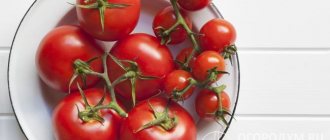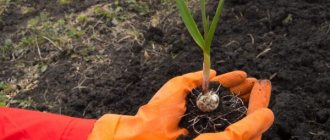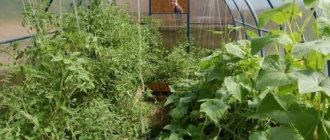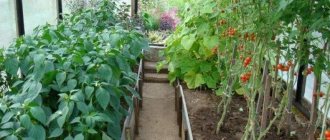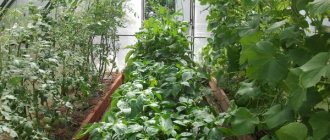The concept of crop rotation is relevant not only for large agricultural enterprises, but also for a small summer cottage. It involves alternating different crops depending on the microelements they consume from the soil. It is especially important to maintain proper crop rotation when planting cucumbers, tomatoes and other greenhouse crops, because the greenhouse area is limited. The article will talk about whether it is possible to plant cucumbers after tomatoes.
Is it possible to plant cucumbers after tomatoes?
This vegetable requires a change of location; it is important to choose the right predecessor, because not all crops can grow well after each other. Changing the place where vegetables are planted is called crop rotation; this term is relevant both on large agricultural lands and on small plots of amateur vegetable growers.
Experience shows that it is possible to grow cucumbers in a greenhouse after nightshades. Tomatoes acidify the soil well, but cucumbers are not afraid of this. Cucumber seedlings are well accepted and produce a good harvest if compost is added to the soil after the tomatoes.
In open ground, cucumbers grow better after zucchini, cabbage and onions than after tomatoes. But many still continue to plant them after tomatoes, even in open ground.
It is also good to grow cucumbers after tomatoes, because they are not susceptible to the diseases that affect tomatoes (for example, late blight). The only thing that can damage both crops together is fungal diseases that develop in long-stagnant soil.
Advice. It would not be correct to alternate only cucumber and tomato crops every year. To prevent the soil from becoming tired, in the third year of planting you can plant eggplants, carrots, and beets in a greenhouse or on an open bed.
In open ground, when alternating cucumbers and tomatoes, for variety and rest of the soil, you can plant carrots or beetroot. It is better to plant peppers right after the cucumbers.
Cucumbers will grow poorly if other representatives of the nightshade family grow behind the tomatoes, as well as garden strawberries or strawberries and melon plants (melons, watermelons, pumpkins).
Is it possible to leave the tomatoes in the same place?
It is not recommended to grow tomatoes in the same place for several years. It must be taken into account that the nutrition of each vegetable crop is carried out through its root system. Tomato seedlings have short roots that consume nutrients only from the top layer of soil.
If tomato seedlings are planted in a garden bed where tomatoes were also grown last year, they will suffer from a deficiency of macro- and microelements, which will negatively affect their growth, development and productivity.
It is best to choose vegetable crops for this area with a deep root system that “pulls” nutrients from the lower layers of the soil. These are eggplants, garlic, radishes or beets.
Gardeners also need to remember that tomatoes are distinguished by their ability to slightly acidify the soil, increasing its acidity level. For full growth and fruiting, this vegetable crop requires slightly acidic soil; accordingly, the tomato yield next year will be significantly lower.
But not every summer resident has the opportunity to change the area for growing tomatoes every year. Owners of small gardens and small greenhouses have to plant tomatoes in the same place every year. In this case, to maintain high yields of vegetable crops, it is necessary to properly prepare the site:
- remove the top layer of soil 5-6 cm thick, and if the tomatoes suffered from late blight - 10 cm;
- to disinfect, spill the soil with a solution of Bordeaux mixture or copper sulfate;
- fill the place of the removed soil with a mixture of leaf or turf soil, sand and humus in equal proportions;
- to reduce the acidity level of the soil during autumn digging, deoxidize it with chalk, dolomite flour or lime;
- In the fall, after harvesting tomatoes, plant winter garlic or green manure in their place.
The use of these agricultural practices helps restore the fertile qualities of the soil. But even when using them, experienced vegetable growers advise changing the area for growing tomatoes every 2-3 years.
Planting cucumber seedlings
After preparing the soil, cucumber seedlings are planted according to the standard pattern. Grown seedlings are hardened by opening the windows and taking the containers with them outside. After 3-4 strong leaves appear on them, they are transferred to a greenhouse or open soil. It is important that the temperature outside is up to + 20°C and does not drop below + 16°C at night. Plant seedlings in fertilized holes at a distance of 50-60 cm.
After harvesting, the remaining greenery is removed, the soil is processed and prepared for the next planting season.
Important! Cucumbers and tomatoes cannot be planted together in the same greenhouse. They will not grow together as expected, one of the crops will wither.
Is it possible not to pick tomato seedlings?
You can do without picking tomato seedlings if you grow them late - at the very end of March-April: tomato seedlings grown without picking are planted at the age of 40 days. Then, by the time the seedlings are planted, the root remains highly branched and powerful (since you do not pinch it). When caring for tomato seedlings that are grown without picking, follow the same rules as when growing with picking.
Is picking really important for growing strong seedlings? You can read more in our article >>>>>>>>
Soil fatigue
Growing the same plants in one place usually leads to a reduction in yield and a deterioration in its quality. It happens:
- Due to soil depletion, since each crop consumes the microelements it needs from the soil, even the introduction of additional mineral fertilizers is not always able to correct the situation.
- Due to the fact that toxins released by plants accumulate in the soil and negatively affect the growth of some subsequent crops.
- Due to pathogenic bacteria and pests that accumulate in the soil, characteristic of a certain type of plant. The most striking example is late blight, the pathogens of which persist in the soil for up to six years and infect initially healthy planting material.
To avoid soil depletion, it is necessary to take into account such features of the plants being grown as the type of their root system, belonging to a certain family, which are necessary for the full development of the substance.
Benefits and chemical composition of fruits
Young greens are 95% water, in which beneficial microelements are dissolved: potassium, phosphorus, calcium, iodine and magnesium. B vitamins, ascorbic acid and fiber contained in fruits help improve metabolism and reduce cholesterol levels. Summer vegetable juices and salads are the best helpers for those who want to lose weight.
In order to fully accumulate the necessary minerals, the plant actively absorbs them from the soil. The root system of cucumbers is located in the top layer (which is why it is so important to maintain its moisture). Root and foliar feeding with complex fertilizers contributes to increasing productivity. They start from the budding phase and are carried out 2-4 times a month.
Is it possible to plant cucumbers after tomatoes?
Cucumbers and tomatoes belong to different families and are neutral predecessors for each other. Alternating cucumbers and tomatoes when planting in a greenhouse is a very convenient option. Cucumbers belong to the melon family, so their diseases are different from those that affect tomatoes and there will be no harm to the crop.
IMPORTANT: you cannot plant cucumbers and tomatoes in a greenhouse at the same time, as these crops require different growing conditions.
What to plant after cucumbers
We hope that we have convinced you of the need to rotate crops in principle, so let’s move on to the main question - what to plant after cucumbers next year.
From the above, you have already understood that the question “is it possible to plant cucumbers after cucumbers” is resolved by itself - we do not recommend it, they can be planted in the previous bed only after 3-4 years. Then which crop to choose?
In general, if there is a possibility, then... none! The fact is that cucumber is one of those “gluttonous” plants with a high need for soil fertility. After a season of intensive farming, it would be nice for the area that was once under cucumbers to rest and gain strength. However, few people can afford to let their land “stand idle” regularly; every hundred square meters of land is worth its weight in gold for summer residents. What to do?
green manure plants after the cucumbers . These plants are also called green manures. And not in vain - their lush green mass, which grows very intensively and quickly, is cut off and buried in the ground without digging. This technique allows you to enrich the soil with valuable nitrogen, inhibits the growth of weeds, and prevents the spread of bacterial and fungal diseases. It is also a good alternative to chemical fertilizers and a suitable option for adherents of natural farming.
As green manure after cucumbers in the garden, they perfectly restore soil fertility:
- legumes (peas, beans, beans, etc.);
- cruciferous vegetables (mustard, rapeseed, radish, etc.).
Moreover, you don’t even have to skip the season - you can pick up green manures that are quite capable of fully vegetating in the time remaining after harvesting the cucumbers from the end of summer until the real cold. So, green manure can be used as soil preparation after cucumbers for other “glutton” plants:
- potatoes,
- rhubarb,
- cabbage,
- corn.
- The best green manure for the garden: how to sow and when to plant it in the soil
Find out which green manures need to be planted on your site to improve the health of the soil and significantly increase the yield.
If you skipped the stage of green manure and plan to immediately grow vegetables after last year’s cucumber plantings, we advise you to pay attention to root vegetables: carrots, parsley, root celery, beets, radishes, turnips . All of them will feel good as followers of the cucumber in the garden beds, because... The root system of cucumbers is located quite superficially, and these plants go underground deep into the ground.
Also an excellent option would be to plant greenery in place of the cucumbers - onions, garlic, dill and other herbs .
potatoes after the cucumbers ; such a predecessor will not cause much harm to it, but do not forget about the proper feeding of the “second bread” - cucumbers still take a lot of energy from the soil.
- Fertilizers for potatoes: which ones to choose and why
Are there ideal fertilizers for potatoes, after which they are guaranteed to give a rich harvest? Find out the answer from the article.
Novice gardeners often wonder if it is possible to plant tomatoes or peppers after cucumbers? In principle, there are no obstacles to this - the plants belong to different families and do not infect each other with possible diseases. However, do not forget that they all have different requirements for growing conditions - if you can arrange a comfortable residence for nightshades in a former cucumber bed, why not.
An interesting option would be to plant in a former cucumber bed not vegetables, but berries ( raspberries, gooseberries, currants ) or ornamental plants ( aster, hydrangea, spirea, clematis , etc.) - all of them will have enough food and space.
After what crops are cucumbers planted?
Plants that enrich the soil with the substances necessary for the development of cucumbers will be excellent predecessors of cucumbers:
- all types of cabbage, since this plant belongs to the cruciferous family and does not leave behind pathogens that are dangerous for cucumbers, and also loosens the soil well.
- legumes and peas will make the soil more fertile by enriching it with nitrogen.
- representatives of the nightshade family, which, in addition to tomatoes, include peppers, physalis, eggplant, and potatoes.
- onions and garlic, which are universal precursors for all plants except themselves.
What soil and growing conditions do cucumbers need?
The soil
Cucumbers prefer loamy or sandy loam, loose, air- and moisture-permeable, neutral or slightly acidic soil with a pH of 6.4-7.
Acidic, alkaline and heavy soils are not suitable for them. In such beds, it is necessary to add rotted humus, peat or moss, sawdust, sand for digging and only then use them for planting or sowing plants. In a clay area, sand is added, and in a sandy area, clay is added.
If the acidity is low, liquid alkaline organic fertilizers are introduced into the soil. For acidic soil, liming is carried out. Slaked lime, crushed chalk, dolomite flour, and ash are added to the soil.
In the fall, after harvesting the beds, the soil is plowed or dug with a full rotation of the layer. Rotted humus or compost, sawdust, ash or lime are added to the ground. 10-15 kilograms of fertilizer are applied per square meter.
In the spring, the soil is dug up again and loosened with a rake or cultivator. 10 days before planting, complex mineral fertilizers are scattered on well-watered beds. Before planting, the beds are spilled with a hot solution of potassium permanganate or copper sulfate.
Seed preparation
For faster germination, seeds are placed for a day in a damp cloth soaked in a weak solution of potassium permanganate.
After this, they are distributed in rows in boxes or immediately sown in individual pots with 2 seeds in each. After germination, the weaker sprout is removed from the pot.
Cucumber sprouts require a lot of light to develop properly. Plants must be illuminated at least 10 hours a day. If there is not enough light, additional lighting (phytolamp) is installed nearby.
Conditions for cucumber seedlings
To grow cucumber seedlings, you need to create an optimal temperature regime. The air temperature before the first cotyledon leaves appear should reach +30 degrees. After germination of the seedlings, the temperature drops to +19–22 degrees during the day and 15–17 degrees at night.
Cucumbers require humid air - 70–80%. Plants need to be watered regularly with warm water. When watering, moisture should not touch the leaves of the plants.
Grown seedlings grown in boxes are transplanted into separate pots.
Before planting in the ground, plants undergo a hardening procedure. To begin with, a few hours of opening the window before seedlings is enough, and later the pots with plants are taken out into the open air, gradually increasing the time they spend outside.
Landing in a permanent place
Sowing seeds or planting seedlings in the ground is carried out after the soil has warmed up to 15 degrees and 20-23 degrees of air.
The optimal temperature for the development and growth of cucumbers is 22-26 degrees. At temperatures below 15 and above 40 degrees, plant growth stops. Short-term frosts are destructive for cucumbers. Sudden changes in air temperature are not desirable.
In open ground, in a bed 1 meter wide, cucumbers are planted in 2 rows, at a distance of 20-30 centimeters from each other. The distance between early ripening varieties is 20 centimeters, mid-ripening varieties are 30 centimeters. Row spacing in greenhouse conditions is 60 centimeters, and in rows 40 centimeters.
A layer of coarse river sand is poured onto the bottom of the prepared and watered holes as drainage.
Cucumbers are planted in open ground when 3-5 true leaves appear. Seedlings 25-35 centimeters high are planted vertically, directly in peat pots or together with a lump of earth. Stretched plants are laid with a slight horizontal slope at the bottom and sprinkled with earth.
When growing vertically, a net or trellis is stretched next to the planted plants, along which the cucumbers will climb.
If necessary, you can provide scenes next to the cucumbers by placing crops or planting between the rows of corn, sunflowers, and beans. It is better to place the scenes across the winds. Seeds are sown in 2 rows along the bed.
In the future, the plants need to be provided with good care.
Water the cucumbers with warm water and only in the afternoon. Cold water causes the stems to crack and become susceptible to disease.
The root system of cucumbers needs air. When the soil is compacted, plants are delayed in development and the ovaries crumble. You need to loosen the top layer of soil after each watering or precipitation. Loosening depth is 3-4 centimeters.
Fertilizers are applied after watering the plants.
Growing cucumbers in open ground All the secrets in one video
After what crops should cucumbers not be planted?
Compatibility table
Plants of the same type should not be used when alternating plants in the garden. Therefore, undesirable options include:
- pumpkins
- zucchini
- watermelons
- melons
All these plants are susceptible to the same diseases as cucumbers, suffer from the same pests and need the same microelements, so their continuous cultivation in the same bed will reduce soil fertility and crop yield.
IMPORTANT: At the end of each season, the soil in the greenhouse is thoroughly disinfected to prevent fungal diseases.
Proper crop rotation, taking into account the characteristics of each type of plant, will help you harvest a good harvest even in a small greenhouse. We can say about cucumbers and tomatoes that they are “friends”. They can be grown one after another, the fruits will grow large and juicy.
Diseases and pests
The most common disease of cucumbers is powdery mildew. It is caused by fungi that actively develop in humid, warm conditions with poor air circulation.
A white-ashy coating covers the leaves, stems, ovaries, disrupting photosynthesis and plant nutrition
It is especially dangerous in greenhouses, where conditions are simply heavenly for it. Powdery mildew is transmitted through soil, contaminated planting material and organic debris. Many other garden crops are also susceptible to the disease, primarily related melons, gooseberries, and roses.
Among the pests that can destroy cucumber plantings, mention should be made of such “generalists” as aphids and spider mites. They live and reproduce on almost all types of plants, and it is difficult to meet a gardener who is not familiar with these parasites.
Vegetable crop rotation table
| Can be planted | Neutral | Can't plant | |
| Potato | Legumes, pumpkins, cabbage | Any root vegetables, onions, garlic | Vegetables from the nightshade family |
| Tomatoes | Pumpkin, legumes, onions, garlic, carrots, all types of cabbage, greens | Beetroot | Potatoes, peppers, eggplants |
| Eggplant, pepper | Cucumbers, zucchini, cabbage, onions, garlic, melons, beans, carrots, greens | Beetroot | Potatoes, tomatoes, pumpkin |
| Onion garlic | Potatoes, legumes, pumpkin crops, all types of cabbage | Beetroot, tomatoes | Pepper, onion, garlic, physalis, greens, carrots |
| Pumpkin crops | Legumes, potatoes, all types of cabbage, tomatoes, onions, corn | Beetroot, greens | Pumpkin crops |
| Legumes | Pumpkins, strawberries, potatoes, all types of cabbage, onions | Beets, tomatoes, greens, carrots, vegetables from the nightshade family | Corn, legumes |
| Carrot | Onions, pumpkins, all types of cabbage, potatoes, greens | Tomatoes, onions, garlic, peppers, eggplants | Carrots, beets |
| Beet | Potatoes, pumpkins, greens | Legumes, tomatoes, onions, garlic, peppers, eggplants, corn | All types of cabbage |
| Cabbage | Onions, garlic, legumes, potatoes, cucumbers, zucchini, pumpkins | Tomatoes, carrots, peppers, eggplants, corn, greens | Cabbage, radishes |
| Greenery | Pumpkins, onions, garlic, legumes | Tomatoes, eggplants, peppers, beets, potatoes, corn | Cabbage, carrots |
Why is there compatibility between different vegetable crops?
When planting different types of crops, you need to take into account that some of them have a depressing effect on others. For example, tomatoes are suppressed by cucumbers, and beans are suppressed by onions. This action is associated with unilateral or mutual shading and differences in demands on growing conditions. However, there are combinations in which plants feel favorable.
What depends on it?
By following the rules of compatibility between different cultures, you can get many advantages:
- Different crops feed on different microelements contained in the soil. This helps to avoid unilateral soil depletion.
- Substances that are released from the roots of one plant affect the size and taste of the neighboring vegetable.
- With proper placement of vegetable crops in the beds, you can harvest from spring until the first frost.
- The various odors emitted by the leaves and fruits of certain plants help repel many pests. This keeps the vegetables healthy.
- Compatibility during planting saves space in the garden.
Planting several plants in one place reduces soil fatigue and makes it possible to abandon crop rotation.
what to plant after what and what interacts favorably with each other? diagram please!
purr
Divide the garden plot into several parts, according to the number of vegetable families that you will grow, plus one empty plot - the land is fallow (the land is resting). Plant pumpkin plants (cucumbers, zucchini, pumpkins, squash, etc.) in one area, nightshades (tomatoes, peppers, potatoes, physalis, etc.) in another, legumes (beans, peas, beans, etc.) in the third. on the fourth – cruciferous vegetables (cabbage, radishes, rutabaga, etc.).
In the spring, before planting, draw yourself a plan of the plot and distribute the vegetables along it. Next year, replace the vegetables in sections. As a result, they will return to their original place only after 4-5 years, when the site is completely free of them. The land that was fallow is occupied by some vegetable family, and now another area is resting. Agronomists advise planting green manure plants in resting soil, which will add useful substances to the soil and will then be used as fertilizer. These can be mustard, rapeseed, lupine. You can plant peas first, and after harvesting them in June, plant green manure.
Hedgehog
First I sow radishes. carrots and dill. Radish under film. Then beets, lettuce, parsley. Then, between the rows of carrots or in a separate bed, preferably after the carrots or cucumbers, I plant onions. Cucumbers must be planted by June 5th. You can use seeds (I plant pecked ones) or seedlings, under a film. After June 12, I plant tomatoes in the greenhouse and zinnias in the bed. I don't plant cabbage. That’s why I won’t talk about her. I grow seedlings of asters, annual dahlias, marigolds, dried flowers and leftovers at home. It is best to plant them after the end of frost. I sow cosmos and calendula in open ground. They are cold-resistant. At the same time, you can sow the seeds into the ground with Levka.
Galina
Everything can be planted after zucchini, cucumbers and peas. It’s good to alternate carrots and onions. From personal experience, it’s bad to plant tomatoes after potatoes, and radishes and turnips after cabbage, but here it’s clear why. Rye heals the soil well, marigolds are good to plant after roses, they disinfect the soil, marigolds are also good to plant along the edge of a strawberry bed, there will be no nematodes.
star Rain
The best predecessors of main vegetable crops are: for green crops (except lettuce) - cabbage, cucumber, root vegetables, onions; for early white cabbage and cauliflower - potatoes, tomatoes, onions, legumes, root vegetables (except radishes, turnips, radishes and rutabaga); for medium and late white cabbage - tomato, potato, legumes, carrots, beets; for onions for turnips - cucumber, tomato, early white cabbage, early potatoes, legumes, late cabbage and potatoes; for cucumber - early white cabbage and cauliflower, tomato, potato, legumes (except beans), root vegetables (except carrots), since beans and carrots are affected by white rot, like cucumber; for carrots - potatoes, cabbage, green crops (except lettuce, which suffers from white rot), tomato, legumes (except beans); for beets - cucumber and other pumpkins, early potatoes, cabbage, tomato and all legumes, late cabbage; for potatoes - cucumber, zucchini, pumpkin, squash, cabbage, legumes, root vegetables, onions; for tomato, pepper, eggplant, physalis - early white and cauliflower, cucumber, zucchini, pumpkin, legumes, onions, root vegetables, late cabbage; for garlic - cucumber, tomato, early white cabbage, legumes, late cabbage.
Video
What can you plant after tomatoes?
Is it possible to plant tomatoes and cucumbers in the same greenhouse?
After which vegetables is it better not to plant? Vegetable crop compatibility table!
What are the good and bad predecessors when growing various vegetables?
GROWING TOMATOES FOR THE SECOND TERM after cucumbers in “sausages”
After what crops can cucumbers be planted?
Crop rotation in the garden. What can you plant in the garden after that?
Crop rotation: scheme for alternating crops in the garden #2
Second planting of cucumbers in July//Latest date for planting cucumbers
DO NOT LEAVE THE GREENHOUSE EMPTY! What to sow after tomatoes and cucumbers?
Crop rotation of vegetable crops
Green manure after tomatoes. Prevention of late blight - 7 cottages
LATE PLANTING OF CUCUMBERS TO INCREASE THE YIELD! CUCUMBERS 2nd and 3rd SEEDING!
SOW THESE SIDERATS IN THE GREENHOUSE after tomatoes, peppers, cucumbers!
Rules for joint planting of vegetables
GROWING TOMATOES AND CUCUMBERS IN ONE GREENHOUSE! COMBINED PLANTING!
These plants should not be planted next to each other
What to plant after beets
How do you like the article?
Ivanova Tatyana
Ask a Question

